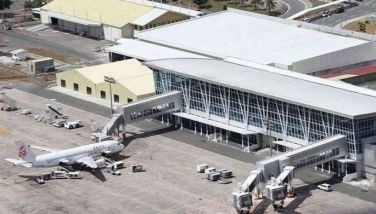Voice Behind the Box
CEBU, Philippines - Audio theater—or more popularly known as the radio drama—may not sound that appealing anymore to the current generation. In fact, there are observations that radio dramas are among the “endangered species.”
But this form of audio storytelling broadcast has been under threat with the 21st century’s other more popular platforms of media. Another is the language being used wherein production would have to consider that it’s catering to the new breed of listeners. Thus the call to reinvent; to “tune in” in return to the voice of the times: in other words, swardspeak is in, formalism out; “slang-uage” in, scrupulous adherence to structured form out!
Above all, the challenge to communicate to today’s listeners is one tough nut to crack.
For example, an attendee of the recent “Voice Behind the Box” seminar-workshop attended by Mass Communications students raised the question: “If tinood gyod mo nga nag-cater sa mga batan-on, ngano man nga gisagolan mag binastos ang inyong mga drama?”
To which, dyHP drama production center manager Jessica Banzon-Natad replied: “We are looking into that. But since we also have to consider the format (if it has something to do with sexual matters raised over an advice program) and cater to a specific market, we have had those seasoned with sexy talk. But yes, we are looking into that, and we are very sorry if you feel offended. However, we are addressing that.”
Writer/director Francis Esparis, meanwhile, sensed that the words, which may have caused such anxiety among youngsters, may have been “torjak” and “jerjer”. In defense of the script, he explained that these are street words with comic connotation to downplay vulgar words. “But yes if hilas ni para sa inyoha, this has to be looked into.”
With the advent of the stickam dot com, radio programs including dramas find a new niche online and reach not only far-flung places here and in Mindanao (like Davao, Cagayan, Iligan, and some parts of Manila where there are Visayans), but the international scene as well. But then the challenge would be “how to entice more people to go back to listening to radio dramas amid the 21st century’s most recent advances in media and information technology?”
Stickam, by the way, is a website devoted to live-streaming, featuring both professional and user-generated content. Stickam features user-submitted pictures, audio, video, and most prominently, live streaming video chat.
Being embedded in our culture, radio drama production nudged the interest of MassComm students of the University of San Jose-Recoletos, Southwestern University, University of San Carlos, University of the Visayas, Cebu Institute of Technology, and University of Cebu, who converged for the seminar-workshop last week to learn more of voice dynamics relative to audio theater, in the hope of leveling up the interest among peers for this specific art form.
Students learned (and relearned) the elements of radio drama from dyHP scriptwriter/drama talent/director Simeon Abadiano Romarate. Sharing the same elements as those of stage drama, the play cannot take form without the dialogue. Romarate underscored that what a character says is essential in a radio play. He, as well, shared how dialogue would tell what a character/role thinks and feels. “Dialogue must tell us where we are, what the character/role is doing, and how the character/role is reacting to what is happening around him/her,” he pointed out.
“As the audience cannot see what is happening, you need to tell them what action is being done. You need to describe what they are doing, or to describe what they can see others doing. And as there is no set to show where the action will take place, a radio scriptwriter must create a picture for the listener with the use of a combination of music and sound effects,” he further said.
When it comes to creating tension, this can be developed by using silence, he said, and also by changing the length of the scene, locations, and the use of music as well as the events in the script. Dialogue can be adjusted, either in a faster or a slower mode.
The students were further taught on the ideas and techniques in the production that centered on core values: being Godly above all things; being confident in one’s self and potential, being humble, honest, obedient and sincere in working with various personality types; and also by working fairly, responsibly and respectfully.
Meanwhile, strategies in voice dynamics of radio drama production centered on knowing the writer and the director; communicating with other talents and sharing real/natural feelings or mood; asking the scripts before schedule; always bringing a pen for marking clerical errors or corrections; and always putting in mind that the script is just the skeleton or a guide. Doing adlibs is a skill to be mastered.
Drama talents, whom Natad would like to redefine as “drama artists”, spend more time in the studio over at home. So that it is advised that in order for dramas to be of infotainment value (informative and entertaining), they have to work in a relaxed atmosphere coupled with the ambiance of camaraderie.
“Also, we join seminars on proper police procedures in capturing law offenders and partner with International Justice Mission with regards to polishing the script. Because dramas are also dynamic, which means dili permanente, ever-changing or evolving, we have to learn to work on concerted efforts in writing of stories. Dili parehas sa una nga scriptwriter ka, ikaw lang gyod,” Natad stressed.
As for Esparis, who was shot to “airlane fame” via his “Ginapos sa Tanlag”, “Ginhawa Delfin” and “Utong Delfin” masterpieces which then gave birth to a sequel “Balibaran Ko ang Kamatayon”, shared of his journey from being a store runner to working with Radyo Bisaya Allied early in his career as an extra from which he received P1.50 talent fee for non-sponsored dramas; and then as a soundman before becoming a seasoned radio actor, writer and director.
With Radio Mindanao Network, he mentioned on how they work on producing quality dramas that certainly leave marks over time and on working their way out of the box – far, now, from the “dramaturgos: mga way nahot” label.
Sound effects, produced by vibrating objects which the brain interprets, make it possible for us to communicate, Esparis said. “Sound is essential in production of voice behind the box as this is the best ingredient in drama,” he added.
Of course there’s the plot or theme, dialogue, spinning or “pahaom sa musika” but sound must be produced—like the fading in and out of footsteps—in synchrony to the dialogue and action. To emphasize galloping horses, it was learned that the team uses “bagol” (coconut shell); cloth being torn for a rape scene; barrel bolts for cocking of pistols; shoes for footsteps; door knobs and drawers for room/office scenes; steel bars for opening of gates; utensils/cutlery to emphasize kitchen/meal table scenes; as well as sound box effects – bamboo, sand and gravel; rice grains for pelting rain.
As a medium of entertainment, it is believed that radio would continue to thrive despite a host of parallels. As a form of entertainment, radio drama and its future take anchor in the nourishment of interest among a new crop of audio storytellers.
Good thing that there’s BoxStraightVoice Production, with Ms. Pearl Jade Bello as event manager, from where a bevy of fresh talents could be sourced out.
- Latest
- Trending























